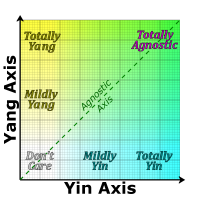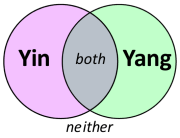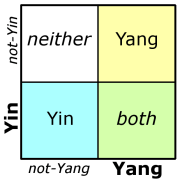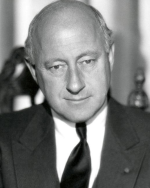 Exactly a year ago I wrote about metaphor as a tool for understanding the world around us. Our metaphors are part of the intuitive window through which we view reality. I think it’s good to have as many windows as possible, both in real life and in metaphor (intellectual rigor and creative insight are the metaphorical equivalent of Windex).
Exactly a year ago I wrote about metaphor as a tool for understanding the world around us. Our metaphors are part of the intuitive window through which we view reality. I think it’s good to have as many windows as possible, both in real life and in metaphor (intellectual rigor and creative insight are the metaphorical equivalent of Windex).
For a very long time, one of my key metaphorical windows has been the notion of Yin-Yang and its implicit notion of balance. One of my first posts was about it. Since then I’ve revisited it in myriad ways (see this, this, this, or this).
Here, among other things, I want to link Yin-Yang to another useful metaphor.
It’s another favorite of mine, one I’ve also written about extensively: parameter space. In particular, I mean the most useful version of it, 2D configuration space. (Another of my first posts introduced it back in 2011).
What makes a 2D space so powerful is illustrated in the image above. It treats Yin and Yang as separate orthogonal axes. When it comes to considerations of things with two sides, it’s often helpful to not see the two sides as a tug-of-war but as separate opinions with their own merits.
The problem with a tug-of-war isn’t so much that it implies a winner and a loser, a zero-sum either/or stance, but that when both sides are strong it leaves one on the fence (like poor Buridan’s Ass). Worse, feeling in the middle can be perceived as “zero” — often both sides see it as a form of desertion. (Agnostics and bisexuals often get crap from both camps of their respective divides.)
But the human mind is capable of superposing conflicting ideas (just as a quantum system can superpose incompatible states). We’ve long known it as a “love-hate relationship” or “running hot and cold” on something. Humans can be paradoxical (which is one reason metaphors can be so helpful in sorting it all out).
§
It’s appropriate that the Yin-Yang concept itself has a meta-Yin-Yang nature — there are two distinct kinds of Yin-Yang pair.
Firstly, there are the “true” Yin-Yang pairs — dualities of opposing poles, such as positive-negative, male-female, or right-wrong. This aspect can often be seen as having orthogonal axes for each pole. For example, every person is some combination of pure male and pure female.
A good metaphor is the North and South literal Poles of Earth. As mathematical points of no size, no one can occupy just the Pole. All real locations are some combination of north-ness and south-ness. What matters is where the location is within the space.
Secondly, there are the “cup” Yin-Yang pairs — which aren’t dualities so much as something versus the lack of that something (the full versus empty cup). A lot of the usual Yin-Yang pairs are, in fact, cup pairs. Cold is the lack of heat; dark is the lack of light; massless is the lack of mass; and so on.
One notable difference between the two is that true pairs often have, implicitly or explicitly, a third option, some blend of neither and both. For positive-negative (charge) the third option is explicit — neutral or zero charge. In the North-South Pole visualization, the equator is more implicit but still represents a distinct object. No other object has the same characteristics.
§
A key aspect of Yin-Yang is that the line is blurred; Yin blends into Yang (and, of course, per the very notion, Yang blends into Yin). There’s always some Yin and some Yang. The line is always blurred.
For example, above I used north and south as opposing pairs, and they can be framed that way if south is seen as a logically distinct direction, not as the lack of north. The physical reality, though, is that moving towards north does move away from south, so physically one is the lack of the other.
Not that it really matters; “true” and “cup” are just ways of seeing more deeply into the notion of Yin-Yang. Of course there’s no clear cut between them.
§
Another observation is that cup Yin-Yang pairs often imply a “zero” state. The cup can be completely empty. Heat, light, for instance, both have zero states.
On the other hand, how the cup fills, and whether it has a limit, varies. Sometimes only one thing fits in the cup, and it’s either there or not. A binary bit, if seen as a cup pair (see below), is a single thing that either is in the cup or not. Something like heat or light fills the cup a little or a lot (but something the the Yang to the Yin of nothing). Note there may be no limit to how full the cup can be. Heat and light can have any value.
True pairs can have magnitudes or discrete choices. Positive and negative voltage can be has any value whereas electrons and positrons are discrete objects. If a “zero” condition exists, it’s the middle third condition.
Again, trying to label Yin-Yang natures precisely rather defeats the purpose and isn’t possible anyway. These are just things to consider when thinking about something. They’re mental tools for analysis.
§ §
 Despite the discrete poles of Yin and Yang, a downright binary concept, Yin-Yang usually makes for a bad Venn diagram.
Despite the discrete poles of Yin and Yang, a downright binary concept, Yin-Yang usually makes for a bad Venn diagram.
Firstly, Venn diagrams are for logical sets of objects, and as just discussed, often the poles have magnitudes, which doesn’t translate well.
Secondly, a key point of Yin-Yang is that nothing is pure — everything real is a blend. That means the actual Yin and Yang sets here are empty, and everything is in the intersection of both.
Thirdly, Yin-Yang doesn’t embody the notion of “neither” since it’s meant to include everything (it’s easy to forget the outside of the Venn circles is also a set — the set of “neither”).
§
 For the same reasons, Yin-Yang also makes a bad four-square diagram. (Which are functionally identical to Venn diagrams but make explicit the “neither” set. This makes them even worse for depicting Yin-Yang.)
For the same reasons, Yin-Yang also makes a bad four-square diagram. (Which are functionally identical to Venn diagrams but make explicit the “neither” set. This makes them even worse for depicting Yin-Yang.)
Such diagrams do make more clear the two-axis nature of (true) Yin-Yang pairs, yet once again, anything real is in the undifferentiated “both” box.
The truth is that both diagram types are explicitly intended for two-axis binary situations. Both are essentially visualizations of two binary bits. As such, they don’t do well with one-axis cup pairs (or with magnitudes). That said, they are a hugely useful visual metaphor for situations that do involve a pair of either-or choices.
(As an aside, binary numbers themselves are a cup pair if “0” is the lack of “1” — which reflects how bits are usually physically implemented — or a true pair if considered as mutually exclusive distinct logical possibilities. Perhaps not surprisingly, the abstraction is true whereas implementations are typically cup.)
The four-square diagram does have one useful feature that points us. It’s a simplified 2D parameter space diagram — one where each axis only has two values: zero and one (or nothing and something).
Which is fine if that’s what you’re dealing with.
§
 But with two-axis magnitudes, where one has some Yin-ness and some Yang-ness, a 2D parameter space is the best representation.
But with two-axis magnitudes, where one has some Yin-ness and some Yang-ness, a 2D parameter space is the best representation.
That’s not surprising, since a two-axis situation naturally maps to a 2D configuration space.
When considering a situation with two sides that can be seen as separate (orthogonal), a 2D parameter space is an easy and helpful visualization.
It’s greatest value in my eyes is the agnostic axis that provides plenty of room for various forms of being in the middle. One can be passionate about both sides, not care at all, or anywhere in between.
Simply put, it expands the territory of possible opinions. As a metaphor, hopefully it expands your window for viewing the world.
§ §
Parameter spaces can have more dimensions (see this or this), but they become less useful as visualizations. 3D works okay (see this), but it’s a major challenge to try to visualize four, and more than that is just abstract math.
Even so, the metaphor of a parameter space with lots of dimensions is useful for the notion of fuzzy characterizing regions within that space. Artificial neural nets build such spaces from their inputs and “recognize” objects as falling into those fuzzy regions.
§ §
For me a key Yin-Yang in life has been that of science and intuition.
I define science as the intelligence-directed process that seeks to converge on an understanding of reality. It is a process that is always contingent and never complete. It is founded on the notion of an external lawful reality we inhabit and proceeds by observing — and trying to make sense of — the patterns of reality.
A simple example is the tiny points of light we see in the night sky. They move. Most move in a certain fixed way; a few move in a different way. Science has progressed through increasingly accurate views of what those points of light are and why they behave as they do.
Science is effective; I’ve been a big fan all my life. I was a science geek from a very early age — easily by second grade. I’ve swam in its waters ever since.
But it isn’t the only valid view of the world. On a pedestrian level, there is art, literature, and music, which touch us on a very different level — an emotional and intuitive level — a subjective level. There are also various forms of spirituality and mysticism that, given their long history and persistence, might speak to a metaphysics science can’t address.
Scientism is seeing science as a cup pair (science versus not-science). It dismisses or excludes the validity, either partially or entirely, of worldviews not strictly based on the protocols of science. The alternative is seeing a true Yin-Yang with science as just one way to discover truth.
The other side of life is more ineffable, which is the very quality that causes many to dismiss it. Those that embrace it represent a spectrum from passions for music or art to mysticism and spirituality. It’s that seemingly more fantastical end of the spectrum that many find especially hard to take seriously, let alone embrace.
It isn’t that scientism always denies intuition, emotion, art, music, or religion, but that it denies them the exploratory or explanatory power — the factual and causal power — of science.
§
A vital point: To speak against scientism is not to speak against science, but against the exclusionary view that scientism can take.
§
Part of that exclusionary view sometimes being a disdain for intuition. Yet the most well-known scientist of all (Einstein) said, “I believe in intuitions and inspirations. I sometimes feel that I am right. I do not know that I am.”
Einstein is a great one for quotes about the value and power of intuition. Here’s another: “Indeed, it is not intellect, but intuition which advances humanity. Intuition tells man his purpose in this life.”
Here’s another good one:
“For it is intuition that improves the world, not just following a trodden path of thought. Intuition makes us look at unrelated facts and then think about them until they can all be brought under one law. To look for related facts means holding onto what one has instead of searching for new facts. Intuition is the father of new knowledge, while empiricism is nothing but an accumulation of old knowledge. Intuition, not intellect, is the ‘open sesame’ of yourself.”
I really like that last line.
One last Einstein quote about why intuition is so useful: “A new idea comes suddenly and in a rather intuitive way. But intuition is nothing but the outcome of earlier intellectual experience.”
Exactly. Intuition are also the result of our low-level consciousness processing data based on our knowledge and experience. (Admittedly, the term is also used for less grounded inspiration.)
I’ve been reading a lot of Agatha Christie lately, and even she has some cogent things to say about intuition:
“Intuition is like reading a word without having to spell it out. A child can’t do that because it has had so little experience. But a grown-up person knows the word because they’ve seen it before.”
That’s from her Miss Marple character. I forgot to note who said this next one, but I believe it’s her Poirot character (who is famous for his deductive reasoning):
“But what is often called an intuition is really an impression based on logical deduction or experience. When an expert feels that there is something wrong about a picture or a piece of furniture or the signature on a cheque he is really basing that feeling on a host of small signs and details. He has no need to go into them minutely — his experience obviates that — the net result is the definite impression that something is wrong. But it is not a guess, it is an impression based on experience.”
As a bit of synchronicity, Peter Woit just posted about Paul Dirac’s 1963 Scientific American article which is in part about the intuition behind the Schrödinger equation. That article also sources a well-known quote:
“I think there is a moral to this story, namely that it is more important to have beauty in one’s equations than to have them fit experiment. If Schrodinger had been more confident of his work, he could have published it some months earlier, and he could have published a more accurate equation. […] It seems that if one is working from the point of view of getting beauty in one’s equations, and if one has really a sound insight, one is on a sure line of progress.”
While “beauty” in the math isn’t a sure bet, to the extent “beauty” is “elegance” and “elegance” is, in part, parsimony, then what beauty in the math really says is that the math expresses what it does in the simplest (but no simpler) way.
§
Lastly, to remain a good and value thing, science (like journalism) must be rigorously intellectually honest. It’s easy to forget, especially with scientism glasses on, that it’s a human process, with all the human foibles that implies. As a friend of mine quipped, “Science proceeds despite scientists.”
It does so long as the process is rigorously honest and self-critical over time. Stacy McGaugh published two powerful posts at Triton Station recently (see: Divergence and Bias all the way down) about how bias can blind us. They’re worth reading.
I took from one these two ideas:
- We know Dark Matter is true, we just have to find it.
- We know MOND is true, we just have to find it.
Both assume a fact not currently in evidence yet some see one or the other as a given. There are similar statements about SUSY, superstring theory, and multiverse theories. For that matter, also about Bigfoot or the Loch Ness monster (or ghosts or angels).
Intuition can become belief, and that’s blinding.
§ §
Lastly, when it comes to science: Experiments are better than theory.
Stay intuitive, my friends! Go forth and spread beauty and light.
∇














May 30th, 2021 at 9:16 am
I’ll be hanging out with my pal Bentley for the next couple of days, so I might be a little slow to respond to any comments.
May 31st, 2021 at 5:30 pm
More synchronicity: This post on Quantum Frontiers touches on the topic of scientific intuition and shows that even certain inanimate objects can have a form of it.
May 31st, 2021 at 6:37 pm
You know my views on intuition. I actually think intuitions are fine, as a first guess. It’s only when we become too attached to them, too unwilling to question them, that they become a problem.
In terms of experiments and theory, they could be considered the yin and yang of science, since they’re both necessary. Theory in the absence of observation is just speculative guessing. And all observation is theory-laden. But I do agree that observation trumps theory.
June 1st, 2021 at 11:20 am
“It’s only when we become too attached to them, too unwilling to question them, that they become a problem.”
Sure. As I said at the end, “Intuition can become belief, and that’s blinding.” I certainly wasn’t advocating blindness there! 🙂
“I do agree that observation trumps theory.”
Facts always trump ideas! (Which is part of why it’s so tragic we apparently live in a “post-factual” world where opinions, emotions, and crazy notions, trump all.)
June 2nd, 2021 at 8:46 am
I think I see intuitions a little different than you or even most people Wyrd. To me, intuitions have nothing to do with beliefs such as a God, unicorns, angels, demons, MWI etc, and they also have nothing to do with “gut” feelings. The type of intuitions I’m talking about are intrinsically linked to the true nature of reality.
I like to refer to Kant on this where he asserted that: Even though we are denied a complete understanding of the “thing-in-itself”, we can look to “it” as a cause beyond ourselves for the representations that occur within us. Those representations that occur within us are the result of our five senses which are a posteriori knowledge as well as intuitive, insightful a priori knowledge. However, most people do not agree with this assessment.
Personally, I think of intuitions as more of a direct revelation if you will, something that strikes you profoundly as “I know not what, only that it is of high value”. It is only later that a cogent articulation can be formed about that insight. I use the metaphor of a computer download as the initial intuitive insight followed by the install which results in an articulation. The articulation occurs over time and often takes several days.
A friend of mine once made a candid statement that stunned me because I could personally relate to his own experience. He said “Whenever I receive a direct revelation, initially I do not like how it makes me feel because those ah ha moments directly challenge what I currently hold to be true.” These events are rare, very rare and very few people experience them; and I have no explanation for that anomaly.
Anyway, thanks for accommodating my thoughts and take care my internet friend.
June 3rd, 2021 at 10:25 am
“…beliefs such as a God, unicorns, angels, demons, MWI etc,…”
😀 😀 at the company you put MWI in. I quite agree, of course.
FWIW, I agree these aren’t themselves intuitions, but I see them as based on metaphysical intuitions people have about the nature of existence. I see that as why we embrace God or MWI as unseen facts — as beliefs.
“However, most people do not agree with this assessment.”
I’m down with Kant’s transcendental idealism. His specific use of “intuition” there (as in our intuition of time) does obviously have broader application. As you say, a direct and deep apprehension of some true fact about our (a posteriori) experience. As that Einstein quote says, “I sometimes feel that I am right. I do not know that I am.”
In some cases it can be years before these insights are given physical substance. The eclipse observations that grounded Einstein’s GR, for instance. In other cases, though, history proves them wrong, as in Einstein’s dice and spooky action. His amazing intuition failed him on those, and that’s the object lesson about intuition.
“These events are rare, very rare and very few people experience them;”
I’m way off the bell curve on a lot of things, and this could be one of them. Or perhaps we’re talking about different things. For some the “Ah, ha!!” moment is well-known and crucial to the process. Such moments aren’t common, but I’m not sure I quite go with “rare” (let alone “very rare”).
They do come from having a very deep training in something — many years of dedicated study sort of thing. Intuition seems to come from the part of our mind we can’t consciously access. They often only come when we stop consciously thinking about something. A favorite example is the one about how William Hamilton, after struggling consciously for some time, came up with the insight about quaternions while walking with his wife.
Perhaps what is rare is having that deep training. Our intuition of time and space likely owe a lot to the wiring of our brains, but beyond that come from our first years of life experience. We get deep training about time and space simply by existing. Come to that, what might also be rare is learning to hear the voice of insight. Many dismiss it, but artists and others seek it actively — the muse.
I’ve been a science geek almost literally since birth; I didn’t discover the art Yang to that Yin until I was a sophomore in high school. That’s where I learned to listen to that voice. Later I connected it back to science, where it is sometimes viewed with suspicion or discomfort.
Rightfully so to some extent. Intuition has to be validated. Einstein’s about light and gravity were game-changing (contingent, but highly validated) truths, but the same man’s intuitions about locality and quantum randomness appear to be false. That’s why, at least in science, experiment trumps theory.
A metaphor: Intuition is like a wormhole in space, but also like a black hole. The former is the only way to get somewhere quickly. The latter is the ultimate wipe out. 😉
June 23rd, 2021 at 9:50 am
[…] I’ve many times pointed out, even Yin-Yang pairs often benefit from two orthogonal axes (see Window with a Worldview), so it should be no surprise that triples do. As just mentioned, many Yin-Yang pairs naturally […]
December 18th, 2021 at 6:13 pm
Thought for the day: I’m an epistemic fundamentalist, and in two senses. Firstly, I believe a good grounding in fundamentals is crucial to understanding the world. The fundamentals are the framework that helps justify and position our knowledge. Secondly, in true fundamentalist fashion, I believe in sticking to the text. In this case that means drawing a hard line between what facts we consider justifiably true and what is speculation, imagination, or sheer fantasy.
I think the world suffers from a serious lack in both senses. Modern culture doesn’t bother with fundamentals because they’re boring, and calling its line between fact and fantasy “blurred” implies it can be seen at all.
October 14th, 2023 at 12:16 pm
[…] seen this used more than once. I’ve used it in this blog more than once. [For instance, see Window with a Worldview.] Figure 1 shows three versions of a four-square diagram. Such diagrams, like Venn diagrams, have […]